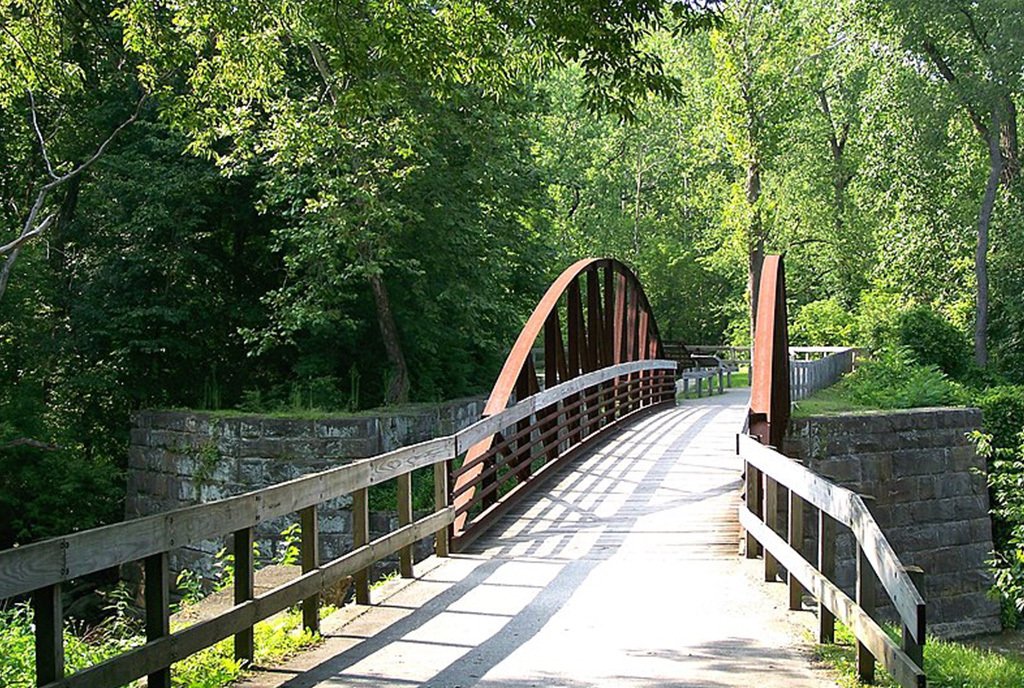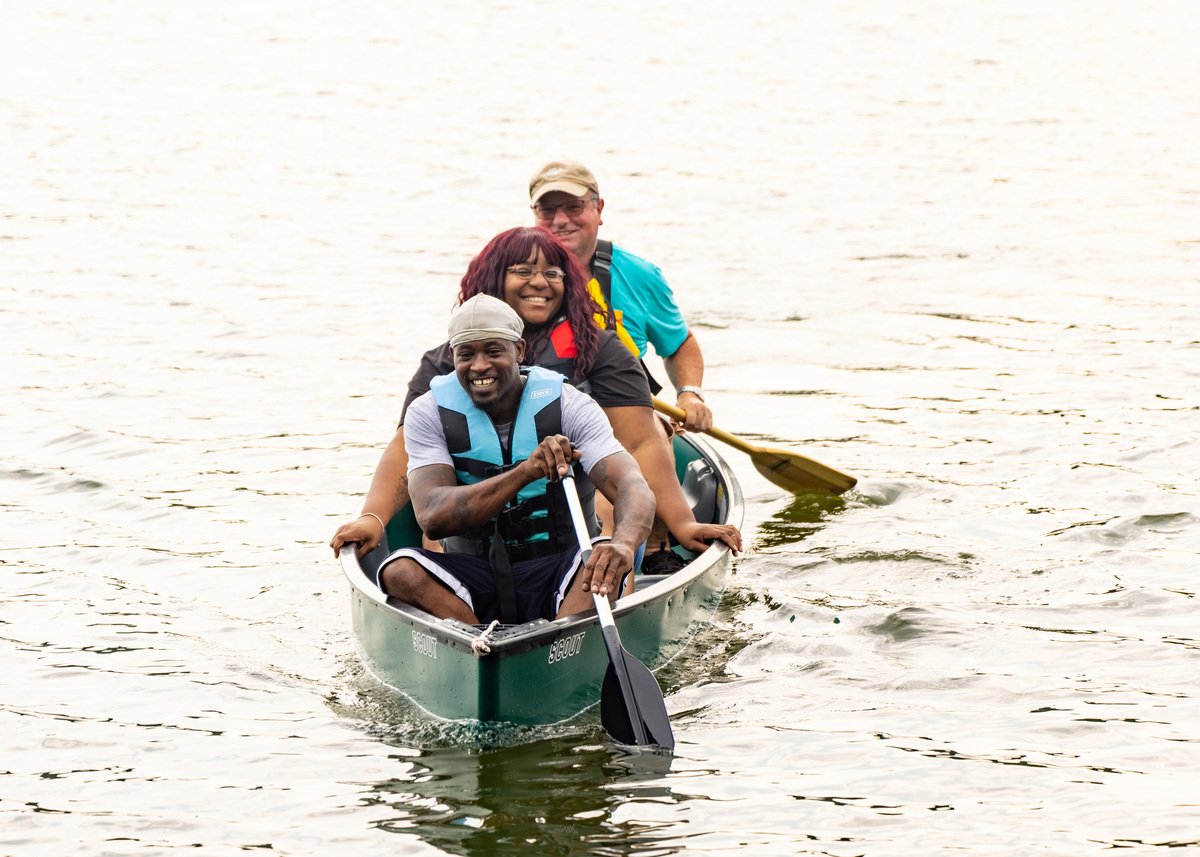
Seven years ago, when resident Starleen Saulsberry learned that a group of people in her city, Akron, OH, were embarking on an effort to reimagine some neglected civic spaces in her neighborhood, she was skeptical. Many times, government and nonprofit representatives had come to Starleen’s Summit Lake neighborhood and indicated that things were going to improve, but not much ever came of it.
“My first thought was, ‘Here we go. A bunch of professionals are coming in to tell us what they are going to do,’” said Saulsberry.
The Scars of History
As in so many disinvested, majority Black neighborhoods, the scars of history run deep. In the 1930s and ’40s, banks and federal government officials redlined Summit Lake—a neighborhood named for its beautiful glacial lake—making it virtually impossible for anyone to qualify for a mortgage in the neighborhood or for any property owner, commercial or otherwise, to qualify for financing to make improvements. In the 1960s, the construction of interstate highway I-76 and state Route 59 disconnected Summit Lake from the rest of Akron. The city’s Black business district was devastated. This was one of many such projects that displaced hundreds of thousands of Black Americans nationwide.
Ongoing neglect and isolation led to entrenched, concentrated poverty and a growing distrust of civic leaders. In the ensuing decades, Akron lost more than 25 percent of its population and suffered economically, especially in places like Summit Lake. Residents invested in their neighborhood as best they could without much institutional or governmental help.
That changed when a team from Reimagining the Civic Commons decided to reinvigorate public spaces in Akron’s systemically disinvested neighborhoods, including Summit Lake.
The result of their work is more places for people to gather and experience nature, increased social cohesion, restored civic trust, and perhaps most importantly, community development that benefits all residents. It’s even shifted Starleen Saulsberry’s skepticism: “The past few years have made me a believer in civic engagement and my own power to affect change.”
Moving at the Speed of Trust
Employing deep listening, engaging in meetings, and building one-on-one relationships with neighbors…helped inform public space design.
In 2016, a cross-organizational team came together in Akron to guide strategic public space investments in three neighborhoods connected by the historic Ohio & Erie Canal Towpath Trail: Summit Lake, Ohio & Erie Canal Park, and Downtown. The team formed as part of a national initiative called Reimagining the Civic Commons, which began in 2015 to explore how improved public spaces could address challenges facing American cities. The initiative spread to four cities, including Akron, the next year.
Supported by five national foundations—JPB, Knight, Kresge, Rockefeller, and William Penn—each city received $4 million from the funder collaborative. In Akron, more than 20 public, nonprofit, and community groups came together to form the Civic Commons team. Among these were the local zoo, a university, a theater project, a parks advocacy group, a neighborhood association, a community development corporation, the local community foundation, and many public agencies—including the county park system, the housing authority, the transit agency, and the city and county governments.
As the Akron team came together, they knew that building trust through authentic relationships with neighbors was critical. Rather than avoid the difficult histories of Summit Lake, the Akron team leaned into working through them. Employing deep listening, engaging in meetings, and building one-on-one relationships with neighbors was illuminating and helped inform public space design.
At one point, the team learned that residents feared the lake because overgrown vegetation made it unclear where the water began, and parents worried that their children might drown. In response, the Akron team began to imagine new uses for the area with residents to see what resonated. The first pilot project was a beachhead at Summit Lake, with large rocks that stepped down to the water’s edge to provide visibility. At neighbors’ requests, they added wooden porch swings, barbecue grills, picnic tables, and umbrellas to draw people in and offer new places to gather. It worked. Indeed, the pilot was so successful the beachhead is now a permanent feature.
Today, residents and park visitors enjoy Summit Lake in myriad ways, such as canoeing and kayaking, fishing, community gardening, enjoying music and arts programming, shopping at a farmers’ market, and visiting a nature center. A bike and walking path that circles the lake will soon be added. All these popular amenities and activities were conceived and constructed in close collaboration with residents.
Building Belief in a Brighter Future
Research shows that people living in neighborhoods perceived as “unsafe” experience all kinds of negative consequences—from poor physical health to increased anxiety and depression, and even reduced interactions with other people. As the Akron Civic Commons team and Summit Lake neighbors worked together to create new neighborhood amenities, they were also able to turn around people’s perceptions of the lake and the neighborhood throughout the city.
At the turn of the 20th century, Summit Lake was a source of drinking water and the site of an amusement park and tile-lined shoreside pool. Summit Lake Park was open from 1917 to 1958, but after the 1950s, redlining, highway construction, and racism resulted in its abandonment. Nearby rubber companies used the lake as a dumping ground for their industrial waste, and eventually local officials declared it too polluted for human use.
That perception of Summit Lake—as polluted and unsafe—stuck through the years with residents and the few visitors. Local urban lore claimed your skin would fall off if you touched the lake’s water. Before 2016, there was only one bench along the 97 acres of the lake, and it didn’t even face the water.
To combat this stigma, the Akron Civic Commons team conducted an environmental assessment, which showed that the lake’s health had dramatically improved since the days of industrial dumping, perhaps due to its natural glacial inflow and outflow as a high point on the Ohio & Erie Canal. Flora and fauna were thriving, and its water was as clean as other urban lakes. Following the assessment, kayaking, canoeing, and fishing programs at the lake grew more popular. Resident fear abated.
Sign up for our free newsletters
Subscribe to NPQ's newsletters to have our top stories delivered directly to your inbox.
By signing up, you agree to our privacy policy and terms of use, and to receive messages from NPQ and our partners.

The stigma attached to the Summit Lake neighborhood was also reduced as more residents interacted at the new beachhead and as joggers, walkers, and bikers began using the Ohio & Erie Canalway Towpath Trail that connects the neighborhood to Downtown. A survey conducted by the Akron Civic Commons team in 2018 showed that 94 percent of visitors to Summit Lake believed the neighborhood had a “bright future.” In 2019, the city’s marathon route ran along Summit Lake’s shores for the first time.
Public Space as an Economic Driver
One spinoff benefit of this seven-year collaborative effort has been new economic activity in Akron’s downtown. As in so many Rust Belt cities, investment and visitors in downtown Akron began to decline in the 1970s. While this decline continued for decades, the intentional focus on public space and public life of the Civic Commons model is beginning to breathe new life into Akron’s downtown.
There are six times more Black-owned businesses downtown than there were five years ago.
For Downtown resident Lori Pesci, the Akron Civic Commons’ focus on public spaces along the Ohio & Erie Canalway Towpath Trail has meant increased engagement in and with her community, resulting in “being able to have input and an impact on where I live.” An example of this work is Downtown’s Lock 3 Park, which is undergoing a $10 million transformation funded partly by federal American Rescue Plan Act (ARPA) dollars. This work is converting what was once a barebones event space into a year-round park, with shaded seating, landscaped gardens, artwork, ice skating, and a performance pavilion.
Near Lock 3 Park, on Main Street, the City of Akron deployed federal grants to convert the street from a fast-moving, four-lane arterial into a “complete street,” with ample and wide sidewalks, protected bike lanes, a robust tree canopy, and reduced automobile speeds.
At the same time, the Downtown Akron Partnership, the local special improvement district, has upped its support of local BIPOC-owned businesses, using small grants and technical assistance to do so. Today, there are six times more Black-owned businesses downtown than there were five years ago, with 22 percent of downtown retail stores now owned by people of color. Suzie Graham, president and CEO of Downtown Akron Partnership, notes that as of 2018 there were only three Black-owned businesses in downtown Akron. By 2022, that number had increased to 18.
Overall, the Akron community has generated $80 million of public and private investment in the city’s public realm over the last six years—a big achievement for a city that suffered significant population loss in the latter half of the 20th century.
Leveraging Public Investment
How does a $4 million foundation investment leverage another $76 million? One thing that Akron teaches us is that modest investments in public space can have significant add-on effects, especially if the foundation investment is used, as it has been in the Civic Commons model, to bring together public, philanthropic, and nonprofit actors with residents to generate a common vision.
For example, spurred by philanthropic investment, the City of Akron doubled its capital budget for parks and recreation projects in 2022, dedicating a substantial portion of its COVID-19 recovery funds to support public investments in Lock 3 Park and Summit Lake. The countywide parks agency, Summit Metro Parks, invested capital funds into transforming an obsolete pump house on the shores of Summit Lake into a nature center. The agency now staffs the center and provides consistent programming for the neighborhood’s young people and adults.
The City of Akron has secured public space funding from several federal sources. This includes a $1 million federal budget earmark for Lock 3 Park, secured partially through the advocacy of the Ohio & Erie Canalway Coalition. The Akron Metropolitan Housing Authority leveraged the improvements at Summit Lake Park to secure a Choice Neighborhoods planning grant from the US Department of Housing and Urban Development. As part of using this grant, the housing agency has adopted the resident-led engagement methods of the Civic Commons team.
One critical change…is a shift in mindset away from a focus on specific projects toward a relationship-based focus.
From “Projects” to Relationships
As the work proceeds, Civic Commons team members have reconceived what it means to build civic trust. One critical change that has occurred is a shift in mindset away from a focus on specific projects toward a relationship-based focus. This has meant, among other things, changing the Civic Commons model to include not just organizational representatives but also residents. Residents sit on steering committees and are hired as park ambassadors, nature center greeters, storytellers, and data collectors.
This work has amplified resident voices in city policy and increased resident power to codirect investments in their own neighborhoods. After seeing the success at Summit Lake, SeKoria Finney teamed up with her neighbors to create a community garden in a nearby vacant lot called Growing Mindz. This memorial garden is a beautiful, thoughtful space tended by a team of local stewards, created by and for neighbors.
Of course, not all is well in Akron. For instance, Akron, like many US cities in the wake of COVID-19, has a higher murder rate than it did before the pandemic. But the Civic Commons team approach has generated mutually beneficial relationships among local government staff, neighbors, nonprofit leaders, and business owners who continue working to improve the city. “Akron Civic Commons is the perfect example of showing people that you have power, you have a voice, you have a say in what your neighborhood looks like,” says Akron City Council President Margo Sommerville.
Most importantly, the team has elevated a new generation of diverse leaders who are contributing new energy to Akron’s civic spaces. At a time when community leadership and innovation are sorely needed, this is no small achievement.









